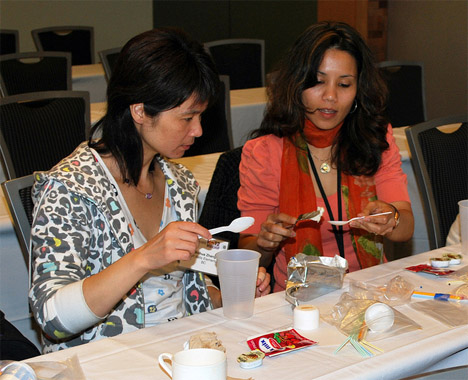Report: K-12 Engineering Teachers Lack Support
 Hands-on learning at ASEE engineering education workshop for teachers.
Hands-on learning at ASEE engineering education workshop for teachers.
In the decade since a prestigious National Research Council panel first proposed a new framework for K-12 science education, engineering has emerged as a critical component of STEM. Today, nearly 80 percent of states and the District of Columbia have either adopted or adapted the Next Generation Science Standards (NGSS) that emerged from that proposal and integrate engineering design and practices with crosscutting science concepts.
Despite this sea change in instruction — and America’s growing need for engineers and innovators to sustain a globally competitive economy — teacher preparation and training remains woefully lacking, a new report from the National Academies of Sciences, Engineering, and Medicine finds.
Building Capacity for Teaching Engineering in K-12 Education highlights not only a growing mismatch between the need for engineering-literate K-12 educators and the capacity of the U.S. education system to prepare and support these professionals, but also how very few postsecondary programs focus on educating prospective K-12 teachers of engineering. Some are in the field of technology education – there were 41 active technology teacher-prep programs in 2017 — and the numbers have been dwindling for years.
Even the nation’s largest STEM teacher preparation program, UTeach, which originated at the University of Texas, Austin, and now extends to 80 universities, sees the vast majority of students pursue science or math degrees. Just 3 percent of UTeach’s 4,500 graduates in 2018 earned a bachelor’s in engineering.
Professional development experiences — through which the bulk of the current teaching workforce learned what they know about engineering and how to teach it — also came up short. The report notes that training varies in “duration, scope, and effectiveness,” with “little evidence” that K-12 science teachers are being given opportunities to learn to incorporate engineering concepts and practices in their instruction, as the NGSS envisions.
Tellingly, the new report found “no evidence” that revised state science tests – as required by the Every Student Succeeds Act – “are attending to specific ideas and practices in engineering.” That omission is particularly glaring, given that ESSA permits states to use federal funds to develop new science tests.
The National Academies’ consensus report includes 10 recommendations for improving the preparation of K-12 engineering teachers. Among them:
- Convening a collaborative dialogue among the many stakeholders to address the capacity issue;
- Ensuring that programs that prepare preservice K-12 science educators or provide professional learning to in-service science teachers address the call in NGSS for students to connect their science learning to engineering ideas and practices; and
- creating partnerships between postsecondary engineering and engineering technology programs with schools/colleges of education to design and implement curriculum for the preparation of K-12 teachers of engineering.
To address engineering’s lack of diversity, the report also recommends programs that teacher-prep programs make greater efforts to recruit and retain candidates from populations currently underrepresented in STEM education and careers.
Further reading and links to engineering professional development for teachers:
- Learn to Teach Engineering: PD Options for PK-12 Teachers.List of summer programs, research experiences, and online learning from the National Academy of Engineering’s LINKEngineering.
- Research Experiences for Teachers. eGFI Teachers blog post on the National Science Foundation program that pays teachers to spend a summer working with a faculty adviser and graduate students in university research lab.
- STEM by Design. December 2014 teaching feature in ASEE Prism on the University of Colorado, Boulder’s Engineering Plus degree program that prepares graduates for jobs as engineers or STEM teachers.
- American Society for Engineering Education’s K-12 Teacher Professional Development resources and P-12 Division – including the 2019 Engineering Education Workshop for teachers held in Tampa, Fla.
Filed under: K-12 Education News, Special Features, Web Resources
Tags: American Society for Engineering Education, and Medicine, Building Capacity for Teaching Engineering in K-12 Education, Education Policy, Engineering, National Academies of Sciences, Professional Development, Research on Learning, STEM education, teacher preparation, Teacher Training








